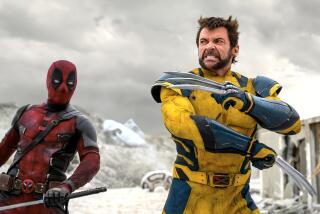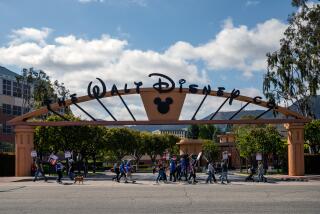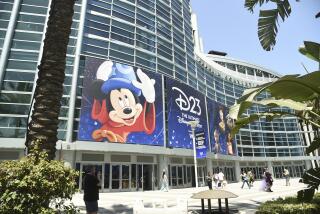Economy Poses Challenge for New Disney Parks President
- Share via
James Rasulo’s new job puts him smack in the middle of the Not-So-Wonderful World of Disney.
Rasulo, who helped turn around Walt Disney Co.’s once-struggling theme park outside Paris, is being called on to do the same thing for the entertainment giant’s entire travel and tourism empire. The operation, along with the rest of the industry, is suffering through one of its worst-ever downturns.
The 46-year-old executive was named last week to replace Paul Pressler, who resigned from Disney as its chairman of parks and resorts to become chief executive of Gap Inc.
Disney’s theme park operating income is projected to fall by a quarter this year, according to analysts’ estimates. The slump has depressed Disney’s stock and turned up the heat on Disney CEO Michael Eisner, who ushered in the company’s vast expansion of theme parks and resorts.
If Disney’s theme parks, which are valued at $19 billion, were listed on the Fortune 500, they would rank No. 265, right behind General Mills Inc.
Now the very successes Disney has had in building its juggernaut have made the company far more vulnerable to economic hard times.
Disney executives were caught off guard by the sharp drop in travel after last year’s terrorist attacks, which deepened a slowdown that was underway in the parks.
“I won’t prognosticate as an economist,” Rasulo said. “I can’t tell you when things are going to turn around. But we are ready.”
Long accustomed to shaping its destiny, Disney now finds itself largely at the mercy of forces beyond its control. Foreign travelers are staying home because of fears of terrorist strikes, Americans are holding on to their wallets and airlines have cut flights by as much as 20%.
“At the television network, Disney can come up with better programming for ABC and the audience will tune in,” said Paul Kim, an analyst at Kaufman Bros. securities in New York. “At the studio, you come up with a big new hit for release at Christmas or Memorial Day and lots of people will buy tickets. But at the theme parks, if people are worried about security or the economy, you can’t convince them to spend thousands of dollars to take a vacation. That’s a much harder sell.”
In such an environment, Rasulo has little room to maneuver. Disney’s theme parks already have undergone financial cutbacks, provoking some fans to say that Disney’s reputation for quality has been hurt. Even before the terrorist attacks, Disney cut 1,000 jobs, mostly in its U.S. theme parks.
By the same token, Rasulo does not have the luxury of spending his way out of the slump because demand is soft and the firm’s other units, especially ABC, are troubled.
“Strategically, he’s in kind of a box,” Kim said of Rasulo. “The parks are at the mercy of the economy. You’d like to spend more on new attractions, but you aren’t making money like you used to.”
Decade of Expansion
In 1990, Eisner outlined a 10-year plan to “do nothing less than reinvent the Disney theme park and resort experience.” The underlying goal was to turn Orlando, Fla., and Anaheim into resort destinations, giving customers a range of entertainment choices that would persuade them to stay longer and spend more money.
“The idea was to create a great guest experience and a lifelong loyalty so guests would keep coming back,” said Judson Green, who led much of the expansion as parks and resorts chairman during the 1990s.
The company would transform Disney World in Orlando--its signature resort--into one of the world’s largest tourist destinations (there’s a running feud with Las Vegas over which is larger). Walt Disney World has more than 20,000 hotel rooms, hundreds of time-share units, four theme parks, two water parks, two cruise ships and a sprawling entertainment complex, including nightclubs and the Canadian circus troupe Cirque du Soleil.
Disney also turned its attention to Anaheim, where its theme park dominance began in 1955. The company added hotels, Downtown Disney and a California-themed amusement park next to Disneyland. At the same time, Disney opened theme parks in Paris and Tokyo. In all, more than 80 million visitors flock to Disney’s 10 theme parks annually.
As it grew, so did chief rival Universal Studios, which in 1999 opened its second theme park in Orlando--Islands of Adventure. The rivalry created what insiders call “an attractions arms race.”
While aggressively adding attractions, Disney boosted its profit by steadily raising admission prices. The strategy worked, helping deliver record profit for Disney year after year.
“The strategy was build, build, build. Every year there was something new,” said David Koenig, a Disney historian and author. “It was an astounding growth period.... Now they’re overexposed.”
By 2001, the giant had begun to stumble as the economy slowed. Then came Sept. 11 and double-digit declines in attendance, particularly among foreign tourists, who are especially coveted because they stay longer than domestic vacationers.
Although most of the pain was felt in Orlando, the $1.4-billion California Adventure theme park also took a hard hit. The park has yet to come close to meeting original attendance projections of 7 million visitors a year. Disney hopes a new attraction opening Monday, Flik’s Fun Fair, will give the park a boost.
Theme park operating income for Disney this year is expected to fall 27% to $1.16 billion, said Prudential Securities analyst Katherine Styponias. By 2003, she said, the business could climb to $1.49 billion, depending on whether the U.S. goes to war with Iraq.
Disney has responded to the crisis by stepping up its marketing, cutting workers’ hours, closing thousands of hotel rooms and cutting back on live-action shows and park hours. At Walt Disney World, the opening of the 5,700-room Pop Century resort was pushed back.
Cuts Not Well Received
Some of Disney’s cutbacks--such as removing popular VIP lounges for annual- pass holders and ending the practice of allowing resort guests to enter the parks an hour early--provoked a backlash. Disney later restored the early admission.
“It’s going to be a difficult process, especially because they’ve done a good job of squeezing costs,” Styponias said. “You don’t want to cut too close to the bone.”
Disney executives say that, because of their actions, the parks and resorts are poised for a recovery when the economy improves.
“The longer the downturn lasts, the greater the pent-up demand will be,” Eisner said at a media conference last week in New York.
Wall Street has praised Disney’s handling of the crisis, especially its ability to cut costs and maximize cash flow. But theme park experts and former Disney executives say Rasulo’s biggest challenge will be to keep the parks fresh and preserve Walt’s goal of creating an emotional connection with guests so they keep coming back.
“Although the cost cutting is necessary and always needs to be part of the agenda, especially in tough times, what really matters to the business is the emphasis on caring about the cast and guest experience,” Green said. “That has to be the guiding principle.”
Verrier is a Times staff writer based in Los Angeles. Johnson is a staff writer for the Orlando Sentinel. Both newspapers are owned by Tribune Co.
More to Read
Inside the business of entertainment
The Wide Shot brings you news, analysis and insights on everything from streaming wars to production — and what it all means for the future.
You may occasionally receive promotional content from the Los Angeles Times.











